MDD指南,MEDDEV 2.12-1 rev.8-2013.01, 医疗器械警戒系统指南
- 格式:pdf
- 大小:663.51 KB
- 文档页数:64
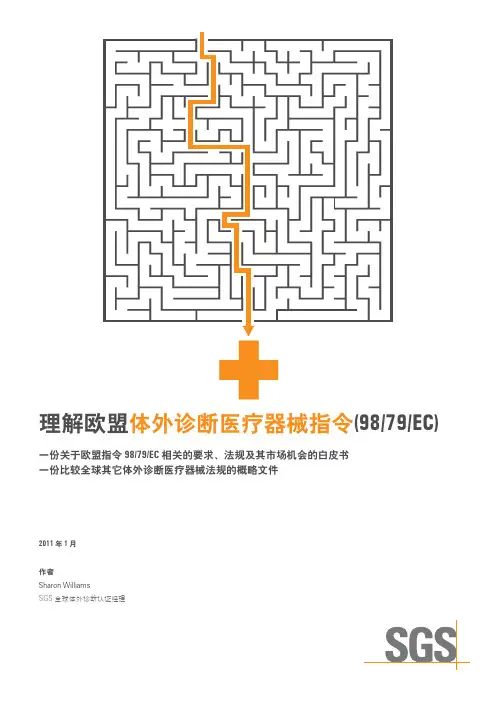
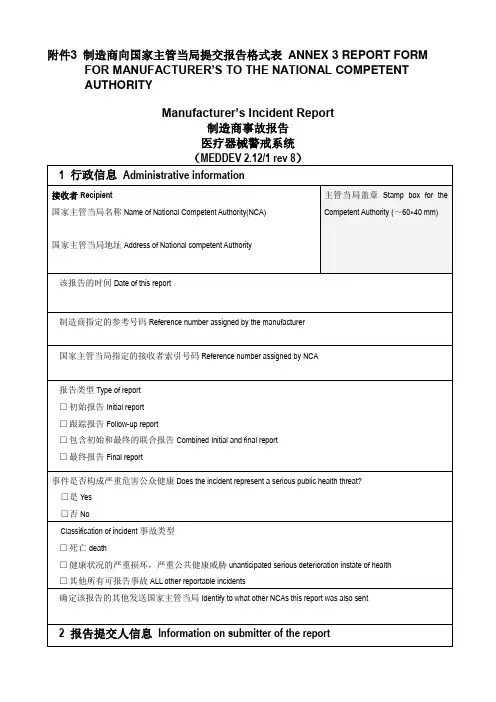
附件3 制造商向国家主管当局提交报告格式表ANNEX 3 REPORT FORM FOR MANUFACTURER’S TO THE NATIONAL COMPETENTAUTHORITYManufacturer’s Incident Report制造商事故报告医疗器械警戒系统本人保证就本人所掌握的知识范围,上述信息是正确的。
I affirm that the information given above is correct to the best of my knowledge.签名Signature姓名Name:城市City:日期Date:Submission of this report does not, in itself, represent a conclusion by the manufacturer and/or authorized representative or the National Competent Authority that the content of this report is complete or accurate, that the medical device(S) caused or contributed to the alleged death or deterioration the state of the health of any person.本报告的提交本身并不代表制造商和/或其授权代表或国家主管当局对本报告的内容完整或准确的结论,也不代表所列医疗器械的任何错误和/或医疗器械引起或促成了宣称的任何人的死亡或其健康六况的严重损坏。
附录4 欧洲市场安全纠正措施ANNEX 4 EUROPEAN FIELD SAFETY CORRECTIVE ACTION REPORT FORM医疗器械警戒系统(MEDDEV 2.12/1 rev 8)本人保证就本人所掌握的知识范围,上述信息是正确的。
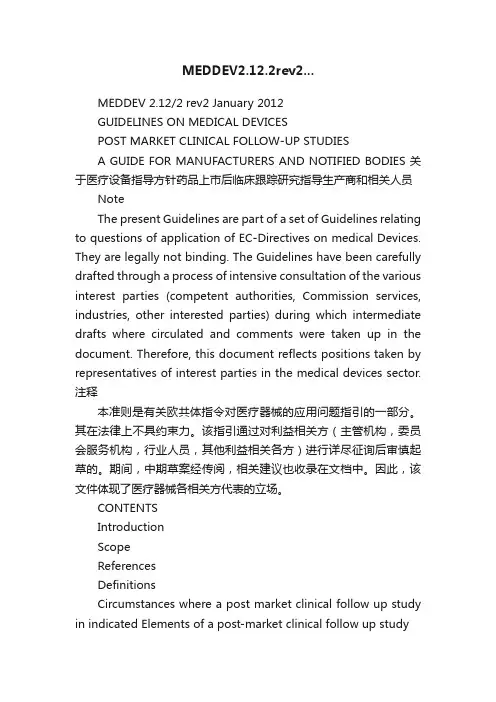
MEDDEV2.12.2rev2...MEDDEV 2.12/2 rev2 January 2012GUIDELINES ON MEDICAL DEVICESPOST MARKET CLINICAL FOLLOW-UP STUDIESA GUIDE FOR MANUFACTURERS AND NOTIFIED BODIES 关于医疗设备指导方针药品上市后临床跟踪研究指导生产商和相关人员NoteThe present Guidelines are part of a set of Guidelines relating to questions of application of EC-Directives on medical Devices. They are legally not binding. The Guidelines have been carefully drafted through a process of intensive consultation of the various interest parties (competent authorities, Commission services, industries, other interested parties) during which intermediate drafts where circulated and comments were taken up in the document. Therefore, this document reflects positions taken by representatives of interest parties in the medical devices sector. 注释本准则是有关欧共体指令对医疗器械的应用问题指引的一部分。
其在法律上不具约束力。
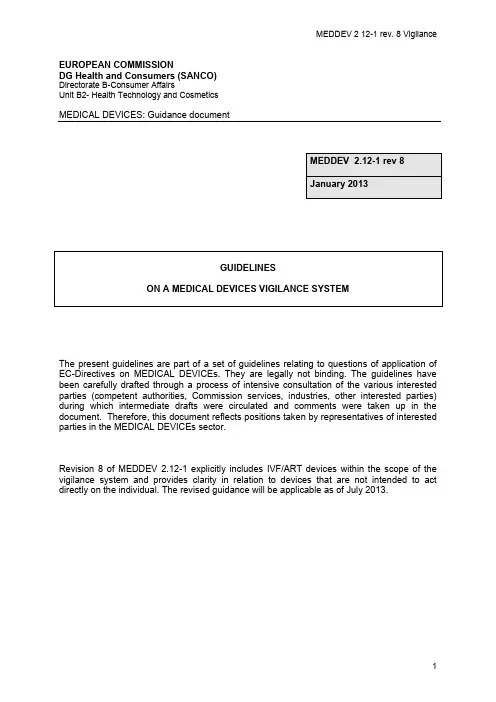
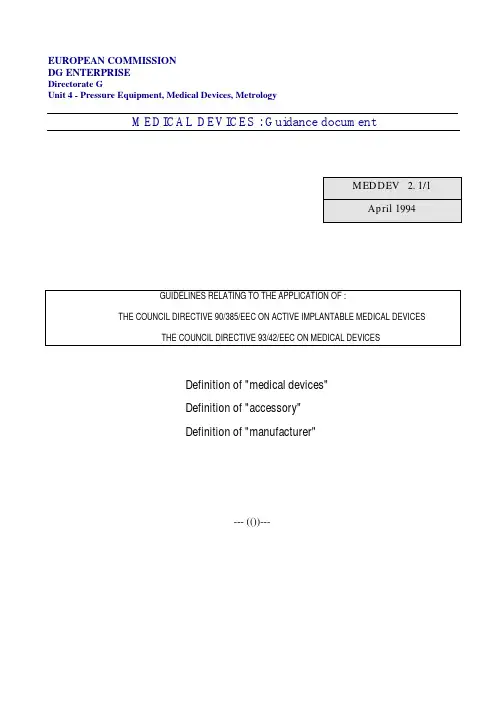
EUROPEAN COMMISSIONDG ENTERPRISEDirectorate GUnit 4 - Pressure Equipment, Medical Devices, MetrologyMEDICAL DEVICES : Guidance documentMEDDEV 2. 1/1April 1994GUIDELINES RELATING TO THE APPLICATION OF :THE COUNCIL DIRECTIVE 90/385/EEC ON ACTIVE IMPLANTABLE MEDICAL DEVICESTHE COUNCIL DIRECTIVE 93/42/EEC ON MEDICAL DEVICESDefinition of "medical devices"Definition of "accessory"Definition of "manufacturer"--- (())---LIST OF CONTENTSI.FIELD OF APPLICATION - DEFINITIONS1.Directive 93/42/EE on medical devices2.Directive 90/385/EEC on active implantable medical devices13.Interface with other directives- medical devices/medicinal products- medical devices/electromagnetic compatibility2- medical devices/personal protective equipment2II.CLASSIFICATION OF MEDICAL DEVICES COVERED BY DIRECTIVE 93/42/EEC3III.CONFORMITY ASSESSMENT PROCEDURES(*):1.CE-marking2.Application-Annex 5-Annex 2. Quality systems. Examination of the design dossier- Annex 33.Conduct of audits44.Format of decisions, design examination certificate5.Technical DossierIV.CUSTOM MADE DEVICES(*):V.DEVICES INTENDED FOR CLINICAL INVESTIGATIONS(*):VI.MEDICAL DEVICE VIGILANCE(*):E OF LANGUAGES(*):VIII.TRANSITIONAL PERIOD(*):1see MEDDEV. 5/93 rev. 22see MEDDEV 13/933see MEDDEV.10/93 rev. 14see MEDDEV. 1/94I.FIELD OF APPLICATION - DEFINITIONS1.Directive 93/42/EEC on medical devices1.1Definition of "medical devices"a)devices - accessoryThe definition of the term "medical device" together with thedefinition of "accessory" is determinant for the delimitation of the fieldof application of Directive 93/42/EEC. A slight difference existsbetween the definition in article 1(2) (a) of Directive 93/42/EEC and inarticle 1(2) of Directive 90/385/EEC.Following the latter directive, accessories are by definition medicaldevices, whilst following Directive 93/42/EEC, a distinction is madebetween "devices" and "accessories". Therefore within the meaning ofDirective 93/42/EEC, accessories are products in their own right and,although being treated as devices (article 1(1)) do not follow, as ageneral rule, the classification of related devices in conjunction withwhich they are used.Accessories are therefore following Directive 93/42/EEC to beclassified in their own right.b)medical purposeMedical devices are defined as articles which are intended to be usedfor a medical purpose. The medical purpose is assigned to a productby the manufacturer. The manufacturer determines through the label,the instruction for use and the promotional material related to a givendevice its specific medical purpose. As the directive aims essentially atthe protection of patients and users, the medical purpose relates ingeneral to finished products regardless of whether they are intendedto be used alone or in combination. This means that the protectionensured by the directive becomes valid for products having a stage ofmanufacture, where they are supplied to the final user.Following this concept, raw materials, components or intermediateproducts are as such normally not medical devices. Such rawmaterials may need to present properties or characteristics which aredeterminant for the safety and quality of finished devices. It istherefore the responsibility of the manufacturer of finished devices toselect and control by adequate means his raw materials orintermediate products (see Annex I, section 7.1; Annex II, section 3.2;Annex V, section 3.2 of Directive 93/42/EEC)Spare parts supplied for replacement of existing components of adevice, the conformity of which has already been established, are notmedical devices. If spare parts, however, change significantly thecharacteristics or performances of a device with regard to its alreadyestablished conformity, such spare parts are to be considered asdevices in their own right.c)customizingThe concept of "finished device" does not imply that a device whenreaching the final user is already in a state ready for use. Prior to usefurther preparatory processing, preparation, configuration,installation, assembling, adaptation or fitting to the needs of the useror patient may be required. Examples :-sterilisation of medical devices supplied non-sterile-assembling of systems-configuration of electronic equipment-preparation of a dental filling-fitting of contact lenses-adaptation of prosthesis to the needs of the patient.The aforementioned activities are normally not manufacturersactivities if they are carried out by the final user as part of the use orpreparation for use. In this context a distinction needs to be madebetween a typical professional activity performed by a healthcareprofessional and processing and assembling activities done by aspecialist for such processing. In the latter case relevant activities maybecome proper manufacturing or assembling activities relevant withinthe meaning of articles 11 and 12.A particular consideration in this context needs to be given for themanufacture of custom-made devices. Custom-made devices (such as dental appliances, prosthesis, hearing-aid inserts) are in most casesone-off devices and the Directive subjects their manufacture to theprocedure of article 11(6) in conjunction with Annex VIII. In thesecases intermediate products specifically intended for this kind ofcustom-made devices may be considered also as medical devices.This applies essentially to dental alloys, dental ceramics, modularcomponents for prosthesis, if the intended purpose of such products is specifically related to medical devices.d)medical - toiletry purposeThe definition of "medical device" should be understood to includeproducts intended to be used principally for a medical use. Thereforeproducts intended to have a toiletry or cosmetic purpose are notmedical devices even though they may be used for prevention of adisease. Examples for products for which a medical purpose cannormally not be established :-tooth brushes, dental sticks, dental floss;-baby diapers, hygiene tampons;-contact lenses without corrective function intended toprovide another colour to the eyes,-bleaching products for teeth [needs to be furtherdiscussed with regard to products intendedspecifically for application by dentists]-instruments for tattooing.Examples for products, where depending on the circumstances, amedical purpose can be established :-incontinence products.e)aids for handicapped personsIn the case of equipment intended for alleviation of or compensationfor a handicap, there must be a direct link between the correctivefunction and the person concerned. Therefore the followingequipment are not medical devices :-acoustic signals at traffic lights,-special water taps, toilet equipment for handicappedf)softwareThe following distinction can be made : software influencing theproper functioning of a device and software used in combination withnon-medical equipment.Software related to the functioning of a medical device may be part ofa device or a device in its own right if it is placed on the marketseparately from the related device.In the case of software intended for use with multipurpose informaticequipment a distinction has to be made between software providingfor a proper diagnostic or therapeutic tool and software for handlinggeneral patient-related data. Only in the first case may a medicalpurpose be determined. Examples for medical devices :-calculation of anatomical sites of the body,-image enhancing software intended for diagnosticpurpose.-software for programming a medical deviceThere is no medical purpose in the case of software used foradministration of general patient datag)multipurpose productsProducts with a multiple purpose which may be used occasionally in amedical environment are normally not medical devices, unless aspecific medical intended purpose is assigned to them. Examples :-multipurpose PC, printer, scanner, ..._magnetoscope, screen.1.2Definition of "accessory"The question whether a product is a "device" or a "accessory" has notpractical consequence. Following article 1(1) of Directive 93/42/EEC,"accessories shall be treated as medical devices in their own right". Therefore the main question is whether a product with a rather remote link to amedical use can still be considered as "accessory" (article 1(2)b) and as amatter of consequence is covered by the directive.The definition of "accessory" requires that the accessory is specificallyintended by the manufacturer of the accessory to be used together with adevice. The intended use of the accessory must be such as to enable a device to be used in accordance with its intended use. Therefore a product can only become an accessory to a medical device if the manufacturer of such aproduct establishes an intended use in conjunction with one or severalmedical devices.Examples for accessories depending on defined circumstances of device-related use :-sterilizers for use in a medical environment,-pouches for packaging re-sterilised medical devices,-specific battery chargers for battery driven electromedicaldevices,-contact lens care products, disinfectants specificallyintended for invasive medical devices-special water treatment device for use in conjunction withdialyzing machines,-gas cylinders/pressure release devices for use inconjunction with anaesthesia machines.1.3Definition of "manufacturer"Users in-house manufacturingThe Directive defines a manufacturer as the natural or legal personresponsible for defined manufacturing activities related to a device with aview to its being placed on the market under the manufacturers own name.The reason for this link with the placing on the market is that the directives aims to subject to its protection requirements the transaction of a device from the sphere of a manufacturer towards the public. The directive does notprovide any specific provisions for the case where a device is manufactured by the user (for example, a hospital) without being transferred to anotherperson. The decision to which extent such in-house manufacturing activities by hospitals are subjected to legal requirements, belongs therefore to thenational legislator. This relates however exclusively to such in-housemanufacturing activities where a device remains within the users, but not to cases where, for example, a hospital produces orthopaedic devices for usewith patients.。
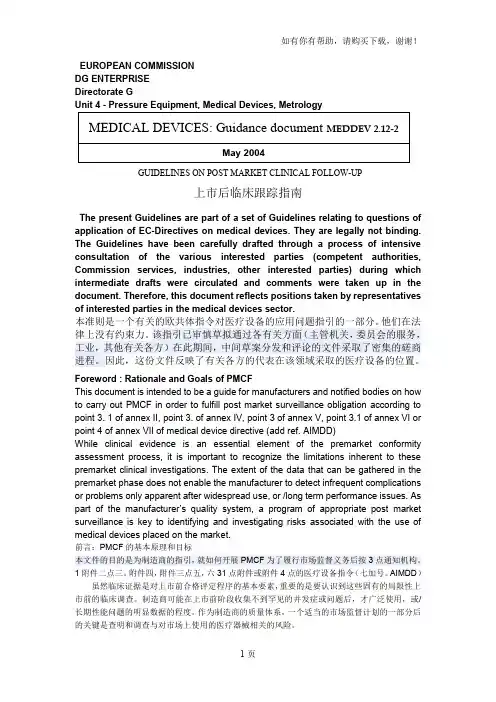
EUROPEAN COMMISSIONDG ENTERPRISEDirectorate GGUIDELINES ON POST MARKET CLINICAL FOLLOW-UP上市后临床跟踪指南The present Guidelines are part of a set of Guidelines relating to questions of application of EC-Directives on medical devices. They are legally not binding. The Guidelines have been carefully drafted through a process of intensive consultation of the various interested parties (competent authorities, Commission services, industries, other interested parties) during which intermediate drafts were circulated and comments were taken up in the document. Therefore, this document reflects positions taken by representatives of interested parties in the medical devices sector.本准则是一个有关的欧共体指令对医疗设备的应用问题指引的一部分。
他们在法律上没有约束力。
该指引已审慎草拟通过各有关方面(主管机关,委员会的服务,工业,其他有关各方)在此期间,中间草案分发和评论的文件采取了密集的磋商进程。
因此,这份文件反映了有关各方的代表在该领域采取的医疗设备的位置。
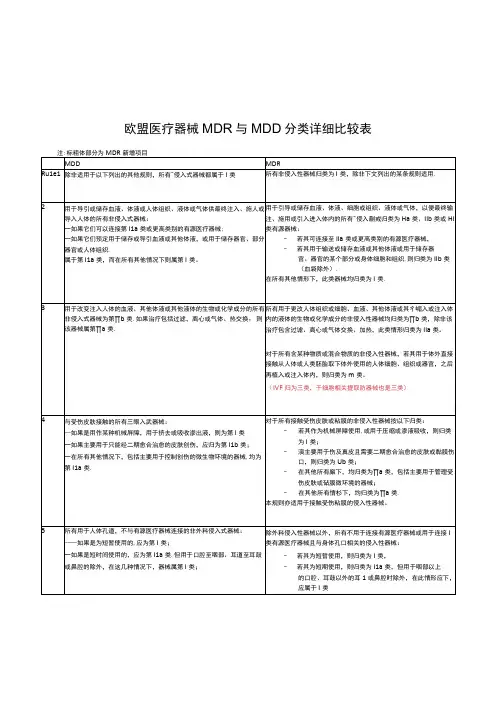
欧盟医疗器械MDR与MDD分类详细比较表
此外以下无医学用途的物品也归类为医疗器械:
1.蒯用于放入眼睛内或放到眼睛上的隐形眼镜或其他物品;
2.为修改解剖学或固定身体部位通过手术创伤的方式整体或部分放入人体内的产品,但纹身产品和穿孔产品除外;
3.预期通过皮下、粘膜下或皮内注射的方式或其他进入方式用于面部或其他皮肤或粘填充的物质、物质组合或物品,但不包括
纹身所用的物质;
4.预期用于减少、去除或破坏脂肪组织的器械,如吸脂术、月鼬分解蜘脂所用的器械;
5.发射高强度电磁辐射(例如,红外线、可见光和紫外线)用于在人体上进行磨皮、纹身或脱毛或其他皮肤治疗的器械,包括
相干和三厢干光源、单色光谱和广谱,如激光和强瞅中光器械;
6.预期使用电流或磁场或电磁场穿透颅骨来修改大脑中的神经元活动,以^凰脑部的器机。
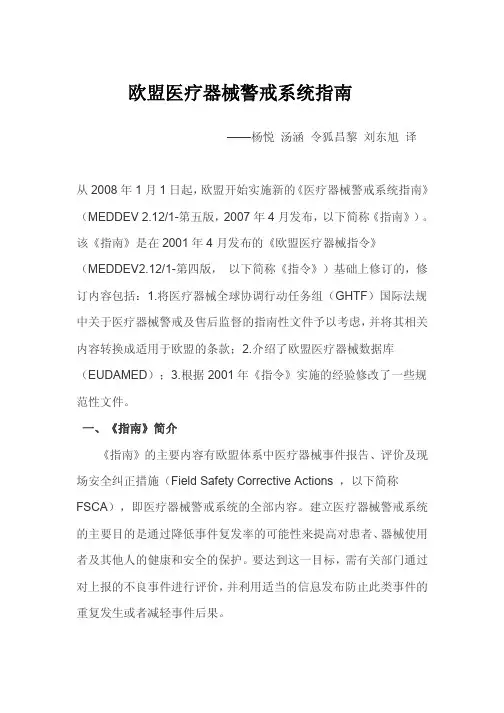
欧盟医疗器械警戒系统指南——杨悦汤涵令狐昌黎刘东旭译从2008年1月1日起,欧盟开始实施新的《医疗器械警戒系统指南》(MEDDEV2.12/1-第五版,2007年4月发布,以下简称《指南》)。
该《指南》是在2001年4月发布的《欧盟医疗器械指令》(MEDDEV2.12/1-第四版,以下简称《指令》)基础上修订的,修订内容包括:1.将医疗器械全球协调行动任务组(GHTF)国际法规中关于医疗器械警戒及售后监督的指南性文件予以考虑,并将其相关内容转换成适用于欧盟的条款;2.介绍了欧盟医疗器械数据库(EUDAMED);3.根据2001年《指令》实施的经验修改了一些规范性文件。
一、《指南》简介《指南》的主要内容有欧盟体系中医疗器械事件报告、评价及现场安全纠正措施(Field Safety Corrective Actions,以下简称FSCA),即医疗器械警戒系统的全部内容。
建立医疗器械警戒系统的主要目的是通过降低事件复发率的可能性来提高对患者、器械使用者及其他人的健康和安全的保护。
要达到这一目标,需有关部门通过对上报的不良事件进行评价,并利用适当的信息发布防止此类事件的重复发生或者减轻事件后果。
该《指南》旨在促进以下指令对医疗器械警戒系统所要求内容的统一应用和实施:1.有源植入式医疗器械指令(the Directive for Active Implantable Medical Devices,简称AIMD),90/385/EEC;2.医疗器械指令(the Directive for Medical Devices,简称MDD),93/42/EEC;3.体外诊断医疗器械指令(the In Vitro Diagnostic Medical Devices Directive,简称IVDD),98/79/EC。
现场安全纠正措施(FSCA)、现场安全通报(FSN)、错误使用和非正常使用均为该《指南》新加入的内容,目的是为了在促进医疗器械全球协调行动工作组(GHTF)制定的法规与欧盟环境相协调过程中,强化和明确欧盟医疗器械警戒系统。
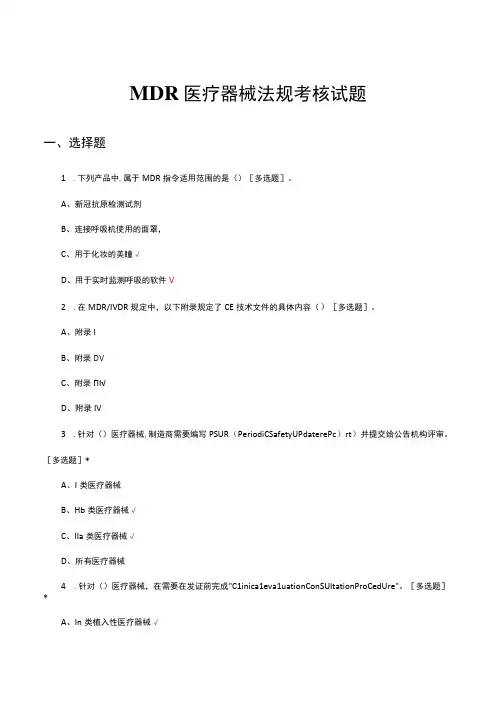
MDR医疗器械法规考核试题一、选择题1.下列产品中,属于MDR指令适用范围的是()[多选题]。
A、新冠抗原检测试剂B、连接呼吸机使用的面罩,C、用于化妆的美瞳√D、用于实时监测呼吸的软件V2.在MDR/IVDR规定中,以下附录规定了CE技术文件的具体内容()[多选题]。
A、附录IB、附录DVC、附录ΠI√D、附录IV3.针对()医疗器械,制造商需要编写PSUR(PeriodiCSafetyUPdaterePc)rt)并提交给公告机构评审。
[多选题]*A、I类医疗器械B、Hb类医疗器械√C、IIa类医疗器械√D、所有医疗器械4.针对()医疗器械,在需要在发证前完成"C1inica1eva1uationConSUItationProCedUre"。
[多选题]*A、In类植入性医疗器械√B、∏a类医疗器械C、∏b类控制药物使用医疗器械√D、所有医疗器械5.11a类和IIb类医疗器械需要在()之前,带有UDI编码才可销售[单选题]。
A、2019-05-26B、2023-05-26C、2023-05-26√D、2025-05-266.医疗器械进行符合性声明(Dec1arationofconformity)包含的内容()侈选题]。
A、附录I+附录UB、附录IVVC、附录IXChaPter1D、产品的分类和分类规则V7.11a类医疗器械的定期安全更新报告PeriOdiCSafetyUPdaterePort(PSUR)需要最少每(泽更新一次,并提供给公告机构审查。
[单选题]*A、一B、二√C、ΞD、四8.对于医疗器械的CE技术文件保存的要求有?()A、要保存在欧盟境内√B、仅由制造商保存即可C、在最后一个器械投放市场后,至少10年,可植入器械至少15年√D、在最后一个器械投放市场后,至少5年9.欧盟的Eudamed数据库将会包含以下信息()[多选题]。
A、UDI-D1数据库B、SRN数据库√C、公告机构资质及CE证书查询数据库√D、临床研究数据库√E、警戒系统及市场抽查数据库V1(λ根据描述,请选择正确的经济运营商类型,把欧洲境外的产品投放欧洲市场的人()[单选题]。
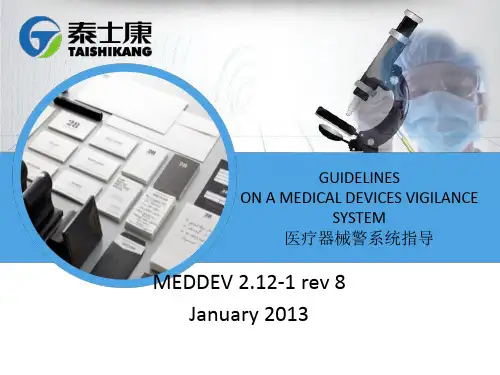
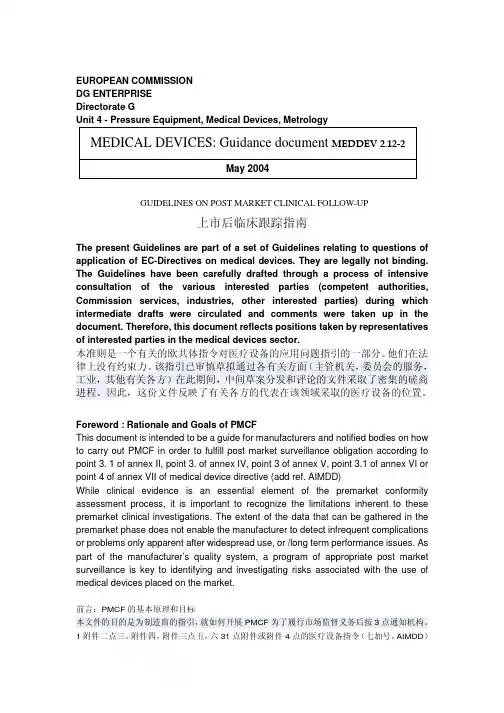
EUROPEAN COMMISSIONDG ENTERPRISEDirectorate GUnit 4 - Pressure Equipment, Medical Devices, MetrologyMEDICAL DEVICES: Guidance document MEDDEV 2.12-2May 2004GUIDELINES ON POST MARKET CLINICAL FOLLOW-UP上市后临床跟踪指南The present Guidelines are part of a set of Guidelines relating to questions of application of EC-Directives on medical devices. They are legally not binding. The Guidelines have been carefully drafted through a process of intensive consultation of the various interested parties (competent authorities, Commission services, industries, other interested parties) during which intermediate drafts were circulated and comments were taken up in the document. Therefore, this document reflects positions taken by representatives of interested parties in the medical devices sector.本准则是一个有关的欧共体指令对医疗设备的应用问题指引的一部分。
医疗器械指令mdd医疗器械指令MDD是目前欧洲可见到的最为全面的医疗器械方面的规定,在该指令中,共有23个条款和12个附录。
其重要部分包括在以下条款中:第1条款:本指令适用于医疗器械及其附件第2条款:成员国必须确保投放其市场和使用的医疗器械是安全的。
第3条款:所谓“安全”的器械应满足附录1中的基本要求。
第4条款:带有CE标志的医疗器械可在欧盟自由流通。
特殊条款(附录Ⅷ和X)允许使用无CE标志客户定制产品及临床研究的产品。
第5条款:符合协调标准的医疗器械被认为满足基本要求。
第8条款:如发现某种器械不安全,本条款允许成员国采取行动。
第9条款:符合性评价程序依据产品的类型而定,分类规则列于附录Ⅸ。
第11条款:医疗器械必须经过一定的程序(程序Ⅱ-Ⅶ中描述)以证明其满足基本要求。
第17条款:满足基本要求并已通过相应的符合性评价程序的医疗器械必须带CE标志。
医疗器械指令的要求可概括如下:①所有的医疗器械应满足指令的基本要求。
②每种医疗器械在投放市场之前,应通过符合评价程序。
③所有已进行相应的符合性评价的医疗器械应带有CE标志。
满足这些要求的责任在于制造商。
在这里所谓“制造商”指的是把医疗器械以自己的名义的投放市场的人,而不管他是否实际生产、由别人代其生产或仅仅销售该器械,制造商的定义使那些原来仅销售而不生产的公司面临了一种全新的情况。
根据指令,现在他们作为制造商必须满足指令中规定的适用他们的所有的义务。
1分类医疗器械的范围从橡皮膏到心肺机,十分广泛,很难有一个统一的规则适用于所有的医疗器械。
因此医疗器械指令采用了一个分类体系。
它把医疗器械分为四类。
即Ⅰ、Ⅱa、Ⅱb和Ⅲ。
I类产品中还包括无菌或具有测量功能的医疗器械的特例,一般用I*表示。
分类是依据创伤性、使用时间、使用部位以及有无能量等准则进行的。
在医疗器械指令附录Ⅸ****有十八条分类标准规则可作为某种器械的分类指导。
该体系的优点在于它的“灵活性”。
对于新型或很少使用的医疗器械也能确认其类型,而不必列出一个貌似完整却需要经常做修改的医疗器械分类目录。
MDCG新指南解读资料MDCG是代表欧洲联盟委员会的指导文件委员会(Medical Device Coordination Group)的缩写。
它负责协调和指导欧盟委员会在医疗器械领域进行指导文件的制订和执行。
最近,MDCG发布了一系列新的指南,为医疗器械行业提供更多的解释和指导。
以下是对其中几个指南的解读:1.MDCG2024-1指南:适用于转移和并购交易的情况下的技术文件的审核这个指南中详细介绍了在医疗器械公司的转移和并购交易过程中,如何审查技术文件。
它提供了一个系统的方法,确保技术文件的准确性和完整性,以及转移过程中的风险评估和监管要求的遵守。
这个指南对于医疗器械公司在业务交易过程中的技术文件审核非常有用。
2.MDCG2024-2指南:委托人和授权代表的职责这个指南解释了欧洲联盟医疗器械法规(MDR)和医疗器械各项法规(MDD)下,委托人和授权代表的职责。
它详细介绍了委托人和授权代表的角色和义务,以及各自需要承担的责任和义务。
这个指南对于医疗器械公司和授权代表了解自身责任和义务非常有帮助。
3.MDCG2024-3指南:披露个人信息的协调和审查这个指南主要针对医疗器械公司在患者和用户数据保护方面的要求。
它详细介绍了个人信息披露的要求,包括患者知情同意和数据处理原则。
同时,它还解释了医疗器械公司在欧洲联盟下的数据保护责任和义务。
这个指南对于医疗器械公司确保个人信息保护合规非常有用。
4.MDCG2024-4指南:风险分类的一致性这个指南解释了医疗器械的风险分类和评估的一致性要求。
它详细介绍了医疗器械的风险分类系统和评估方法,以及相应的法规要求和指导。
这个指南对于医疗器械公司在评估和管理产品风险时提供了清晰的指导。
总的来说,MDCG的新指南为医疗器械行业提供了更多的解释和指导。
这些指南涵盖了转移和并购审核、委托人和授权代表职责、个人信息披露和风险分类等关键领域。
医疗器械公司可以借助这些指南更好地理解和遵守欧洲联盟的法规要求,确保他们的产品和业务合规。
附件3 制造商向国家主管当局提交报告格式表ANNEX 3 REPORT FORM FOR MANUFACTURER’S TO THE NATIONAL COMPETENTAUTHORITYManufacturer’s Incident Report制造商事故报告医疗器械警戒系统本人保证就本人所掌握的知识范围,上述信息是正确的。
I affirm that the information given above is correct to the best of my knowledge.签名Signature姓名Name:城市City:日期Date:Submission of this report does not, in itself, represent a conclusion by the manufacturer and/or authorized representative or the National Competent Authority that the content of this report is complete or accurate, that the medical device(S) caused or contributed to the alleged death or deterioration the state of the health of any person.本报告的提交本身并不代表制造商和/或其授权代表或国家主管当局对本报告的内容完整或准确的结论,也不代表所列医疗器械的任何错误和/或医疗器械引起或促成了宣称的任何人的死亡或其健康六况的严重损坏。
附录4 欧洲市场安全纠正措施ANNEX 4 EUROPEAN FIELD SAFETY CORRECTIVE ACTION REPORT FORM医疗器械警戒系统(MEDDEV 2.12/1 rev 8)本人保证就本人所掌握的知识范围,上述信息是正确的。
MDR医疗器械法规试卷您的姓名: [填空题] *_________________________________您的部门: [填空题] *_________________________________1、下列产品中,属于MDR指令适用范围的是(); *A、新冠抗原检测试剂B、连接呼吸机使用的面罩(正确答案)C、用于化妆的美瞳(正确答案)D、用于实时监测呼吸的软件(正确答案)2、我司将在2022年申请CE认证,届时我司的审核依据将是() [单选题] *A、MDD 93/42/EECB、MDR (EU) 2017/745(正确答案)C、IVDR(EU)2017/746D、ISO 9001:20153、在MDR/IVDR规定中,以下附录规定了CE技术文件的具体内容() *A、附录IB、附录II(正确答案)C、附录III(正确答案)D、附录IV4、针对()医疗器械,制造商需要编写PSUR (Periodic safety update report)并提交给公告机构评审。
*A、I类医疗器械B、IIb类医疗器械(正确答案)C、IIa类医疗器械(正确答案)D、所有医疗器械5、针对()医疗器械,在需要在发证前完成“Clinical evaluation consultation procedure ”。
*A、III类植入性医疗器械(正确答案)B、IIa类医疗器械C、IIb类控制药物使用医疗器械(正确答案)D、所有医疗器械6、IIa类和IIb类医疗器械需要在()之前,带有UDI编码才可销售 [单选题] *A、2019-05-26B、2021-05-26C、2023-05-26(正确答案)D、2025-05-267、医疗器械进行符合性声明(Declaration of conformity)包含的内容?()附录I + 附录II附录IV *A、附录Ⅰ+附录ⅡB、附录Ⅳ(正确答案)C、附录IX Chapter ID、产品的分类和分类规则(正确答案)8、IIa类医疗器械的定期安全更新报告periodic safety update report (PSUR)需要最少每()年更新一次,并提供给公告机构审查。